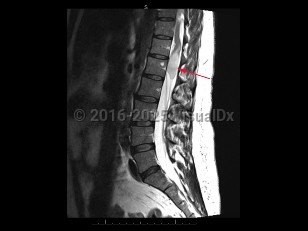Emergency: requires immediate attention
Cauda equina syndrome
Alerts and Notices
Important News & Links
Synopsis
Cauda equina syndrome is a neurologic emergency where damage to the lumbosacral plexus leads to loss of lower motor neuron function. Trauma, tumors or abscesses, large lumbar disk herniation, and spinal stenosis are some of the etiologies of this condition.
Onset is typically gradual but can be acute. Signs and symptoms include severe back pain that may radiate into one or both legs, saddle anesthesia, leg weakness or paraplegia, urinary or bowel dysfunction, sexual dysfunction, and gait disturbance. There may be reduced or absent patellar, Achilles, anal, and bulbocavernosus reflexes.
Prognosis depends on severity and duration of compression or damage to the affected nerves.
Onset is typically gradual but can be acute. Signs and symptoms include severe back pain that may radiate into one or both legs, saddle anesthesia, leg weakness or paraplegia, urinary or bowel dysfunction, sexual dysfunction, and gait disturbance. There may be reduced or absent patellar, Achilles, anal, and bulbocavernosus reflexes.
Prognosis depends on severity and duration of compression or damage to the affected nerves.
Codes
ICD10CM:
G83.4 – Cauda equina syndrome
SNOMEDCT:
192970008 – Cauda Equina Syndrome
G83.4 – Cauda equina syndrome
SNOMEDCT:
192970008 – Cauda Equina Syndrome
Look For
Subscription Required
Diagnostic Pearls
Subscription Required
Differential Diagnosis & Pitfalls

To perform a comparison, select diagnoses from the classic differential
Subscription Required
Best Tests
Subscription Required
Management Pearls
Subscription Required
Therapy
Subscription Required
References
Subscription Required
Last Reviewed:05/08/2018
Last Updated:04/26/2023
Last Updated:04/26/2023
Emergency: requires immediate attention
Cauda equina syndrome

